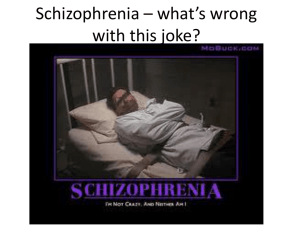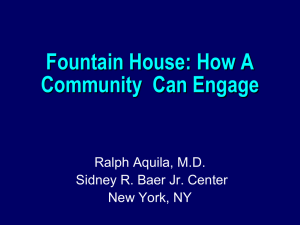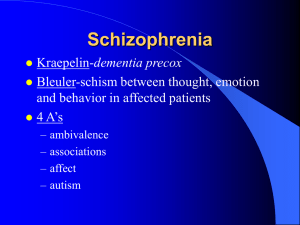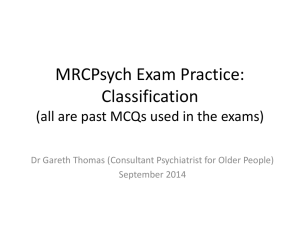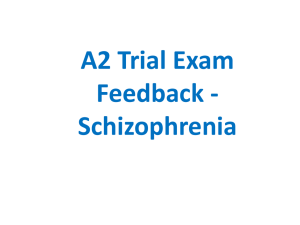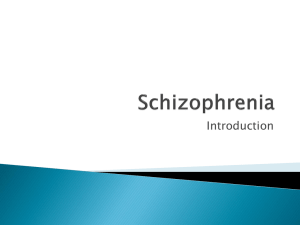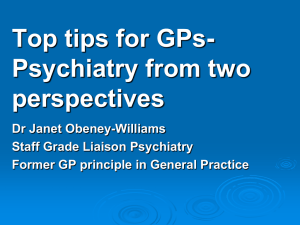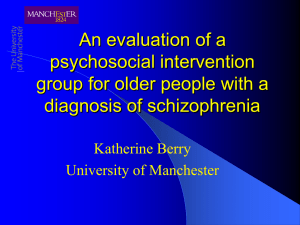Schizophrenia - Napa Valley College
advertisement
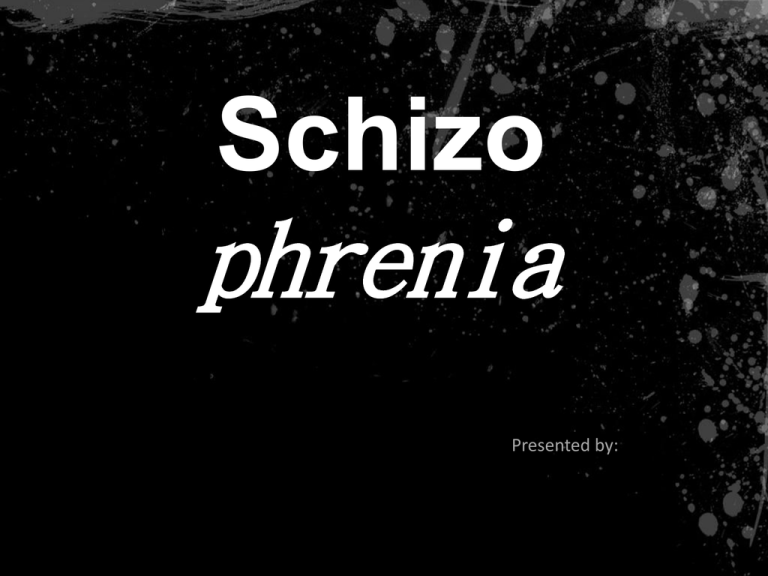
Schizo phrenia Presented by: Summary • The following presentation is a brief compendium of images and information concerning Schizophrenia. • We will first look at what is Schizophrenia and its symptoms followed by its anatomical and biological criteria. • The presentation will conclude by looking at Diagnosis, Demographics, Treatment, and Research. • It was first classified by Dr. Emile Kraepelin in 1890, although historical documents have identified schizophrenia as far back as Pharaonic Egypt. At that time it was believed to be an illness of the heart and uterus. What is Schizophrenia? o Schizophrenia: a long-term mental disorder of a type involving a breakdown in the relation between thought, emotion, and behavior, leading to faulty perception, inappropriate actions and feelings, withdrawal from reality and personal relationships into fantasy and delusion, and a sense of mental fragmentation. o General: a mentality or approach characterized by inconsistent or contradictory elements o Greek Roots: schizo (split) + phrene (brain) Symptoms & Clinical Presentation • Hallucinations – Audio and Visual • Delusions – Contradictory fantasies • Disorganized thought – Leading to impaired speech • Impaired judgment • Social Withdrawal • Emotional Difficulty – Can’t read emotions • Memory impairment • No percieved self control Schizophrenic Self Portrait demonstrating feeling of no self control Schizophrenia Classifications A. Paranoid Schizophrenia Most common type. Normally hear threatening voices and have frightening thoughts. Tends to develop later in life than other forms and also gets better with treatment B. Disorganized Schizophrenia The rarest but most serious form of Schizophrenia. Patients with this form have unpredictable and sometimes dangerous behavior. They often make up words and sentences. Also called Hebephrenic Schizophrenia C. Catatonic Schizophrenia Rare in which the patient stands or sits still for extended periods of time called a catatonic stupor. This is followed by meaningless intense activity called catanoic excitement. D. Undifferentiated Schizophrenia E. Residual Schizophrenia Gray Matter Deficits, UCLA Laboratory of Neuroscience MRI Created by repeatedly scanning 12 patients and 12 matched controls during the same intervals over a five year course period. STG is the superior temporal gyrus, while DLPFC is the dosolateral prefrontal cortex. Clinical Diagnosis • American Psychiatric Association’s Diagnostic and Statistical Manual of Mental Disorders. • World Health Organization’s International Statistical Classification of Disease and Related Health Problems. • Criteria: Delusions, Hallucinations, Disorganized thoughts due to Formal Thought Disorder, disorganized or catatonic Behavior, and Negative Symptoms. Risk & Demographics • • • • Above image is of two Monozygotic twins who are 44 years old. The image on the right shows the unaffected twins smaller ventricle, while on the left, the enlarged ventricles can clearly be seen. http://www.schizophrenia.com/family/disease.htm • • • 0.3 – 0.7% of people or 24 million people worldwide 1.4 times more frequent in Males than Females Peak age onset age is 20 – 28 years in Males and 26 – 32 years in Females. Childhood or middle age is much rarer. Hereditary. A first degree relative increases the risk up to 46%. Urban environment Drug uses, 2x risk. Winter or spring births, possibly due to utero viral exposures Treatment • Typical: older antipsychotics – – – – • Atypical: second generation antipsychotic drugs – – – – – – • Chlorpromazine (Thorazine) Haloperidol (Haldol) Perphenazine (Etrafon, Trilafon) Fluphenazine (Prolixin). Risperidone (Risperdal) Olanzapine (Zyprexa) Quetiapine (Seroquel) Ziprasidone (Geodon) Aripiprazole (Abilify) Paliperidone (Invega) Side effects: severe enough that many pateints refuse to take the drugs. – – – – – – – Drowsiness Dizziness Blurred vision Rapid heartbeat Sensitivity to the sun Skin rashes Menstrual problems for women Research- SIRS • UTHSC Cell Transplant Treatment: instead of patients taking antipsychotic drugs, researchers are looking into cell transplants which would replace damaged cells of schizophrenia via stem cells. • Early Diagnosis: early intervention is essential in improving prognosis. This primarily means looking at the disease during the Prodormal phase. Research is looking into ways of diagnosing Schizophrenia by definitive clinical testing via biological markers as well as ways of identifying prodromal symptoms. • Schizophrenic medications currently in Phase III trials: – – – – – – – – Asenapine (for positive/negative symptoms) Bifeprunox (positive, negative, cognitive symptoms; relieve side effects) Iloperidone/Zomaril (positive, negative, cognitive symptoms) Lamictal (adjunct therapy; may improve positive symptoms) Osanetant (for movement side-effects caused by traditional neuroleptics) Paliperidone (for treatment-refractory patients) RG1068 (for autistic-type symptoms in schizophrenia patients) Seromycin/d-cycloserine (adjunct treatment, for negative symptoms) Concluding Statement • In conclusion we looked at the classifications, symptoms, effects, treatments and research of Schizophrenia. • Although Schizophrenia is a horrible disorder it is important to note the success stories of people like John Forbes Nash. He was an American mathematician and economist of Princeton University and is also the recipient of the 1994 Nobel Memorial Prize. He accomplished so much even tho was diagnosed as Schizophrenic. His life is the subject of the 2001 film A Beautiful Mind References • http://en.wikipedia.org/wiki/File:Artistic_view_of_how_the_world_feels_l ike_with_schizophrenia_-_journal.pmed.0020146.g001.jpg • http://en.wikipedia.org/wiki/Schizophrenia • http://www.schizophrenia.com/schizpictures.html# • http://en.wikipedia.org/wiki/Schizophrenia • http://www.schizophrenia.com/family/disease.htm • http://www.nimh.nih.gov/health/publications/schizophrenia/index.shtml • http://bionews-tx.com/news/2013/09/10/uthsc-researcher-reveals-celltransplants-as-possible-novel-schizophrenia-treatment/ • http://www.psychiatrictimes.com/articles/biological-markers-and-futureearly-diagnosis-and-treatment-schizophrenia • http://www.webmd.com/schizophrenia/classification-of-schizophrenia • http://en.wikipedia.org/wiki/File:John_Forbes_Nash,_Jr._by_Peter_Badge.j pg


